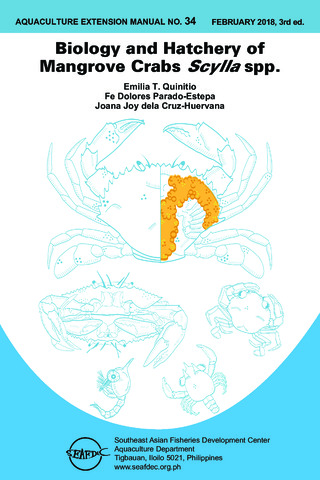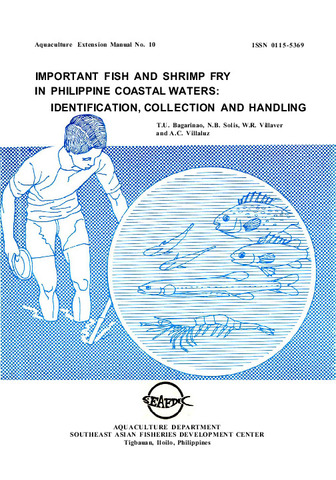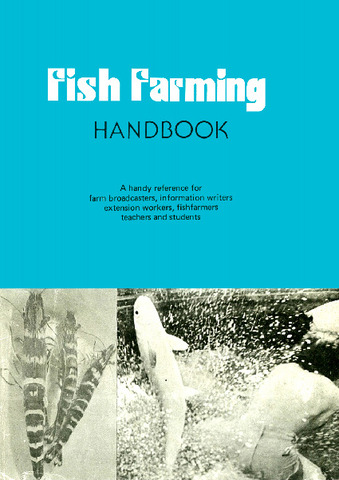| dc.contributor.author | Tobias-Quinitio, Emilia J. | |
| dc.contributor.author | Libunao, Gardel Xyza S. | |
| dc.contributor.author | Parado-Estepa, Fe D. | |
| dc.contributor.author | Calpe, Adelaida T. | |
| dc.date.accessioned | 2016-08-26T06:34:34Z | |
| dc.date.available | 2016-08-26T06:34:34Z | |
| dc.date.issued | 2015 | |
| dc.identifier.citation | Tobias-Quinitio, E. J., Libunao, G. X. S., Parado-Estepa, F. D., & Calpe, A. T. (2015). Soft-shell crab production using hatchery-reared mud crab. Tigbauan, Iloilo, Philippines: Aquaculture Department, Southeast Asian Fisheries Development Center; Los Baños, Laguna: Philippine Council for Agriculture, Aquatic and Natural Resources Research and Development. | en |
| dc.identifier.issn | 0115-5369 | |
| dc.identifier.uri | http://hdl.handle.net/10862/3056 | |
| dc.description.abstract | "The production of soft-shell crabs is well established in other Asian countries but its sustainability is already being threatened due to the decreasing mud crab population in the wild where the seedstocks are sourced. In the Philippines, production of soft-shell crabs has only been practiced recently due to lack of seedstock and technology. Sourcing of crablets from the natural environment is not encouraged due to dwindling populations of all sizes of mud crabs. Instead, it is recommended that crablets for soft-shell crab production come from hatcheries. The project on soft-shell mud crab production at SEAFDEC/AQD started in 2012 and was later funded by the Philippine Council for Agriculture, Aquatic and Natural Resources Research and Development of the Department of Science and Technology. The project is adopting the individual crab culture sytem of Thailand and Myanmar in pilot-scale and uses hatchery-reared crablets grown to 60-100 g in earthen ponds and stocked in trays. The pilotscale soft-shell production set-up is showcased at the Dumangas Brackishwater Station of SEAFDEC/AQD using crab boxes available in the country. Various sectors are interested to learn how soft-shell crabs are produced. Hence, the previous manual on Soft-shell Mud Crab Farming by Emilia T. Quinitio and May Myat Noe Lwin published in 2009 was revised to include the recent refinements using hatchery-reared crabs and locally available materials. This manual includes sections on the biology of mud crab, how to set-up the facility, management of soft-shell crab production and the cost and return analysis. We hope that various sectors will benefit from this revised manual" -- Foreword | en |
| dc.description.sponsorship | SEAFDEC/AQD appreciates the financial support provided by the Philippine Council for Agriculture, Aquatic and Natural Resources Research and Development of the Department of Science and Technology. The authors acknowledge the assistance provided by the Dumangas Brackishwater Station crab team, Robert Pierre Ragus, Noel Opina, Roderix Escosa, Nestor Ardales, Ronnie Tenefrancia, Jose Masa, Ritchie Andrada and Jerry Babiera during the conduct of the project. | en |
| dc.format.extent | 25 pages : illustrations (some color) ; 23 cm | en |
| dc.language.iso | en | en |
| dc.publisher | Aquaculture Department, Southeast Asian Fisheries Development Center | en |
| dc.publisher | Philippine Council for Agriculture, Aquatic and Natural Resources Research and Development (PCAARRD) | en |
| dc.relation.ispartofseries | Aquaculture extension manual; No. 61 | en |
| dc.subject | Scylla serrata | en |
| dc.subject | South East Asia | en |
| dc.subject | Philippines | en |
| dc.subject.lcsh | Crab culture -- Handbooks, manuals, etc. | en |
| dc.subject.lcsh | Mud crab culture -- Handbooks, manuals, etc. | en |
| dc.subject.lcsh | Soft-shell crab culture -- Handbooks, manuals, etc. | en |
| dc.subject.lcsh | Crab culture -- Southeast Asia | en |
| dc.title | Soft-shell crab production using hatchery-reared mud crab | en |
| dc.type | Book | en |
| dc.subject.asfa | crab culture | en |



